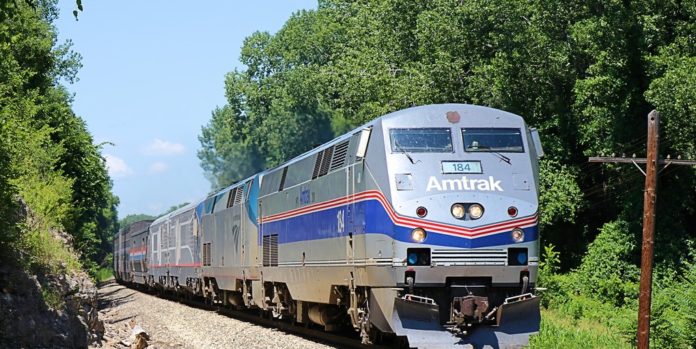Kansas is about to lose daily train service later this month when Amtrak is planning to cut service on the Southwest Chief to three times a week.
Amtrak has a plan for restoring daily train service in Kansas and on other long-distance routes, but questions persist about whether it will ever return.

“Once you reduce service, it’s almost impossible to get it back,” said Nick Hernandez, city manager for Dodge City, one of six Kansas stops along the Southwest Chief’s route.
“They’ve been wanting to eliminate the Southwest Chief for years,” he said. “This was not anything that was brought on by the pandemic.”
The new three-times-a-week service is set to begin Oct. 12.
The Southwest Chief provides a vital transportation connection to western Kansas, making daily stops in Hutchinson, Garden City and Newton on its cross-country route from Chicago to Los Angeles. It also stops in Topeka, Lawrence and Kansas City.
However, train ridership was hit hard when the pandemic took hold in the spring as governments across the country put limits on movement and mass gatherings to contain the spread of the coronavirus.
At one point, Amtrak said ridership was down as much as 95% year-over-year.
Additionally, the demand for long-distance service was down by 70%, and Amtrak expects systemwide ridership in fiscal year 2021 to be half of what it was in 2019.
In April of this year, the Chief’s ridership plummeted almost 90% from a year earlier, falling from 23,798 in April 2019 to 3,375 in 2020.
Ridership was down about 51% in March 2020 compared to March 2019, dropping to 13,258 from 27,191 last year.
By July, ridership on the Southwest was down about 69%, falling to 11,849 this year from 38,464 last year.
Amtrak has promised to restore daily service by next year, although there are some who worry if it will return.
“Once something gets away from you, you’re always anxious about whether you’re going to get it back,” said Republican state Rep. Brad Ralph, who sits on the Midwest Interstate Passsenger Rail Commission.
“I want to be optimistic, but you’re always hesitant in those circumstances when something gets away,” he said. “It’s critical for us out here in the rural areas.”
Amtrak’s executives promise it will come back.

“One thing I want to make absolutely clear: these long distance frequency reductions are temporary,” Amtrak president and CEO Bill Flynn told a congressional committee in early September.
“We are committed to continuing to operate our current long-distance network and to improving the service we provide to our long distance passengers,” Flynn said.
Flynn has indicated that Amtrak needs at least $4.9 billion, including $2.8 billion in supplemental funding, to cover losses caused by the pandemic to maintain daily long-distance service while avoiding employee furloughs.
Flynn detailed three benchmarks that would be used for determining whether daily service would be restored if Amtrak doesn’t receive the money or Congress doesn’t direct that full-service be restored. The metrics include:
- Are COVID-19-related hospitalization rates in the regions through which a given long-distance route operates stable or declining?
- Are customers booking trips at nearly the same rate as in 2020? Is the percentage of available seat- and room-miles booked for 2021 at least 90% of the percentage for June 2020, taking into account any limits on ticket sales to foster social distancing or other measures adopted to minimize COVID-19-related risks?
- Is ridership close to Amtrak’s projections? Was systemwide ridership in the first quarter of fiscal year 2021 at least 90% of the projected figure in Amtrak’s fiscal 2021 operating plan, which already accounts for reduced ridership due to COVID-19?
Jim Mathews, president and CEO of the Rail Passengers Association, said he doesn’t foresee a full return to daily service unless Congress intervenes.

“If this trajectory were to continue without any kind of alteration,” he said, “I think the odds of a full return of daily service would be pretty poor.”
Mathews said Congress either could come up with the money Amtrak needs to run daily service or direct Amtrak not to cut train operations.
Mathews said the situation in Congress is fluid, conceding that his optimism changes from day to day depending on how things are shaping up on Capitol Hill.
The organization is hopeful because there is $2.5 billion for Amtrak in the latest version of the coronavirus relief bill proposed by Democrats.
The bill also contains language that would prevent Amtrak from cutting service on long-distance routes except in cases of an emergency, maintenance or construction.
“These critically needed funds would avert catastrophic cuts to the U.S. transportation network and speed the economic recovery for thousands of towns across the nation,” the Rail Passengers Association said in a statement.
Mathews said in an interview that it was inevitable the Chief will see at least see some service reduction because Amtrak has already telegraphed that it would take several weeks to reverse the planned service changes.
The Rail Passenger Association has been critical of the metrics Amtrak wants to use next February to decide whether to bring back daily service.
The organization said it will be hard for those long-distance routes to meet the ridership benchmarks when they will be compared against a record ridership year while providing less robust passenger rail service.
“We have serious concerns over the dampening effects on passenger demand that these reductions in service will have,” the group contended in its analysis of the metrics.
“With reduced connections, increased uncertainty over when the trains will be restored, and lower levels of onboard service, we foresee a chilling effect on bookings.”
Mathews said it’s harder to meet those metrics considering that Amtrak was on pace to have a record ridership year for fiscal 2020 before the pandemic hit.
“That’s a hell of a yardstick to say, ‘We’re not going to bring the service back until we get back to the adjusted equivalent of record ridership'” Mathews said.
“Maybe you ought to take a lower baseline than last year’s record.”
Mathews points out how the change in service affected two long-distance train routes on the East Coast earlier this year.
He said when Amtrak moved from daily service to three-times-a-week service on two eastern routes – the Silver Star and the Silver Meteor – ridership suffered much more than it had during the pandemic.
The two routes, which run from New York to Miami, had been hit severely during the pandemic but not as bad as other long-distance routes, the passenger rail group said.
The routes ranked fifth and sixth for revenue among Amtrak’s 15 long-distance routes in June, the group said.
After the change on July 6, the two routes ranked eighth and and 11th in revenue in August.
Before the routes went to three times a week, one saw a 61% decline in ridership while the other dropped by 65% in July.
After the change in August, one route saw ridership fall 72% and the other 71%. They experienced the worst ridership decline in the long-distance system.
Moving to less frequent service three times a week just isn’t a winner with riders because connections and schedules are bad, Mathews said.
“People aren’t going to ride those trains. They’re just not. The utility simply isn’t there,” he said.
“You see immediately what happened when you cut this service,” Mathews said of the two New York-to-Florida routes.
“The trains immediately become less attractive,” he said.
Republican U.S. Sen. Jerry Moran has been a staunch advocate for preserving long-distance rail service through Kansas.
Back in June, Moran coauthored a letter with other members of the Senate Committee on Commerce, Science and Transportation.
The letter was sent to Amtrak’s Flynn expressing concern about the service reductions.
“Although we support Amtrak’s efforts to use resources efficiently and responsibly, particularly in response to COVID-19, we would like to ensure that reductions in frequencies for long-distance routes do not unnecessarily extend beyond the COVID-19 crisis,” the letter said.
A spokesman for Moran said the senator “is working closely with Amtrak since their service reduction announcement over the summer to make certain Amtrak’s intent is to restore service to the Southwest Chief.
“Sen. Moran is also monitoring the metrics that Amtrak will use to make this determination,” the spokesman said.













